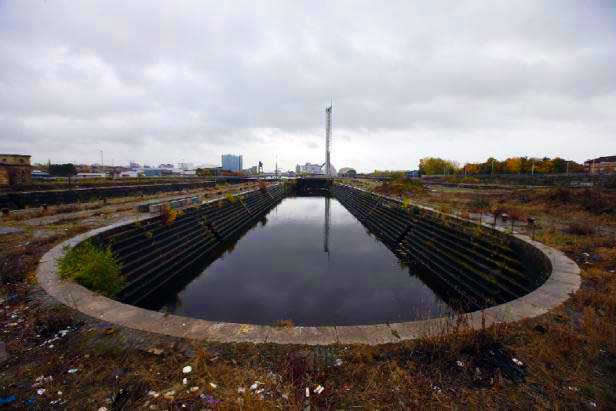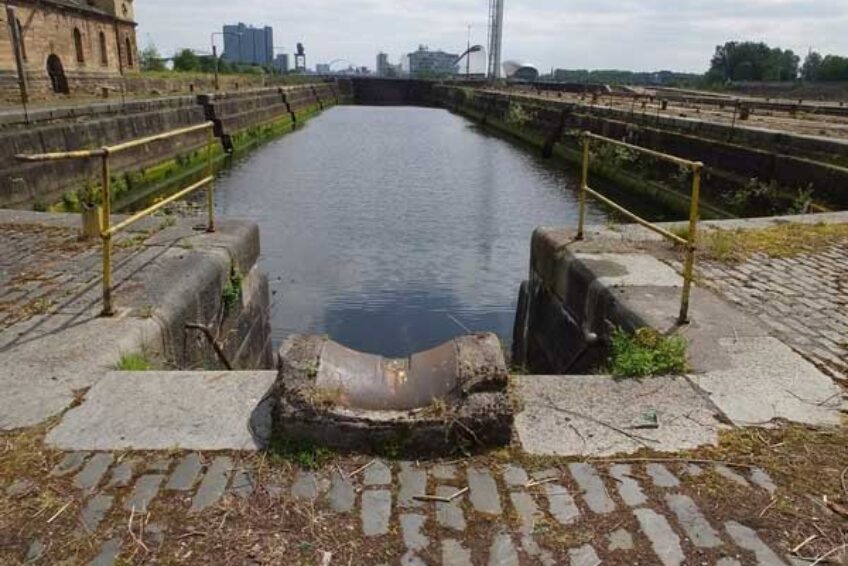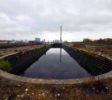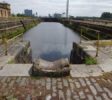
Govan’s remaining Graving Docks were built in 1869-98 by James Deas and Alex Lister for the Clyde Navigation Trust.
The site consists of three large drydocks that were capable of accommodating the largest ships in the world when they were built. The dock walls are of solid granite and despite showing much cosmetic wear they are likely to be structurally intact.
The site is Category-A listed and identified in the Register for Scotland as being at risk. It is a significant part of Glasgow’s industrial heritage, but despite this since closing down, it has fallen into disrepair through years of neglect.
The hope is to create a NEW shipbuilding heritage park on the site. As much as possible of the existing dock structure would be retained, including the renovation of the gorgeous pump house building as a café and visitor centre.
Most other docks in Glasgow have been filled-in to make way for modern developments and this is one of the few remaining docks on the once-bustling shipbuilding centre on the Clyde, apart from those still in operation.
The site is one of the most important features of Glasgow’s industrial heritage and represents a major opportunity to educate future generations about the city’s past in a way that is more meaningful than looking at old photographs in a museum.
Described on the Heritage at Risk Register as:
An outstanding graving dock complex without parallel in Scotland. 3 major dry docks, associated quays, capstans and bollards, pumphouses, workshops and other ancillary buildings, retaining and boundary walls, ramped accesses and stairs. The dock walls and quay edges are of grey granite, the working surfaces whinstone setted, and retaining walls and ramp sides are of cream sandstone. Cast-iron gatepiers.
The docks here were built for the Clyde Navigation Trust during the years when the Clyde yards led the world in the building of sophisticated merchant ships, so the complex is of architectural and historical interest internationally. It is of major significance in terms of the history of the world shipbuilding.
Govan Graving Docks # 1 and # 3 were the deepest in Britain and could take the largest ships in the world when they were built.
Glasgow was once at the forefront of global shipping and there is still potential for Govan Graving Docks to be used partly as a working dry dock again. This could allow restoration of historic ships to be done as a key feature of the development.
The Clyde Docks Preservation Initiative was set up to establish a lead organisation in efforts to secure the future of Govan Graving Docks as a maritime heritage asset. See their website HERE! They are asking everybody to put forward their ideas about the project as well as running design competitions for architects.
Read the Buildings at Risk entry HERE!
Follow the blog by the Clyde Docks Preservation Trust HERE!
Sign the petition HERE!
#SaveGovanDocks
18 Clydebrae Street, Glasgow, G51 2BG.

Govan’s remaining Graving Docks were built in 1869-98 by James Deas and Alex Lister for the Clyde Navigation Trust.
The site consists of three large drydocks that were capable of accommodating the largest ships in the world when they were built. The dock walls are of solid granite and despite showing much cosmetic wear they are likely to be structurally intact.
The site is Category-A listed and identified in the Register for Scotland as being at risk. It is a significant part of Glasgow’s industrial heritage, but despite this since closing down, it has fallen into disrepair through years of neglect.
The hope is to create a NEW shipbuilding heritage park on the site. As much as possible of the existing dock structure would be retained, including the renovation of the gorgeous pump house building as a café and visitor centre.
Most other docks in Glasgow have been filled-in to make way for modern developments and this is one of the few remaining docks on the once-bustling shipbuilding centre on the Clyde, apart from those still in operation.
The site is one of the most important features of Glasgow’s industrial heritage and represents a major opportunity to educate future generations about the city’s past in a way that is more meaningful than looking at old photographs in a museum.
Described on the Heritage at Risk Register as:
An outstanding graving dock complex without parallel in Scotland. 3 major dry docks, associated quays, capstans and bollards, pumphouses, workshops and other ancillary buildings, retaining and boundary walls, ramped accesses and stairs. The dock walls and quay edges are of grey granite, the working surfaces whinstone setted, and retaining walls and ramp sides are of cream sandstone. Cast-iron gatepiers.
The docks here were built for the Clyde Navigation Trust during the years when the Clyde yards led the world in the building of sophisticated merchant ships, so the complex is of architectural and historical interest internationally. It is of major significance in terms of the history of the world shipbuilding.
Govan Graving Docks # 1 and # 3 were the deepest in Britain and could take the largest ships in the world when they were built.
Glasgow was once at the forefront of global shipping and there is still potential for Govan Graving Docks to be used partly as a working dry dock again. This could allow restoration of historic ships to be done as a key feature of the development.
The Clyde Docks Preservation Initiative was set up to establish a lead organisation in efforts to secure the future of Govan Graving Docks as a maritime heritage asset. See their website HERE! They are asking everybody to put forward their ideas about the project as well as running design competitions for architects.
Read the Buildings at Risk entry HERE!
Follow the blog by the Clyde Docks Preservation Trust HERE!
Sign the petition HERE!
#SaveGovanDocks
18 Clydebrae Street, Glasgow, G51 2BG.



